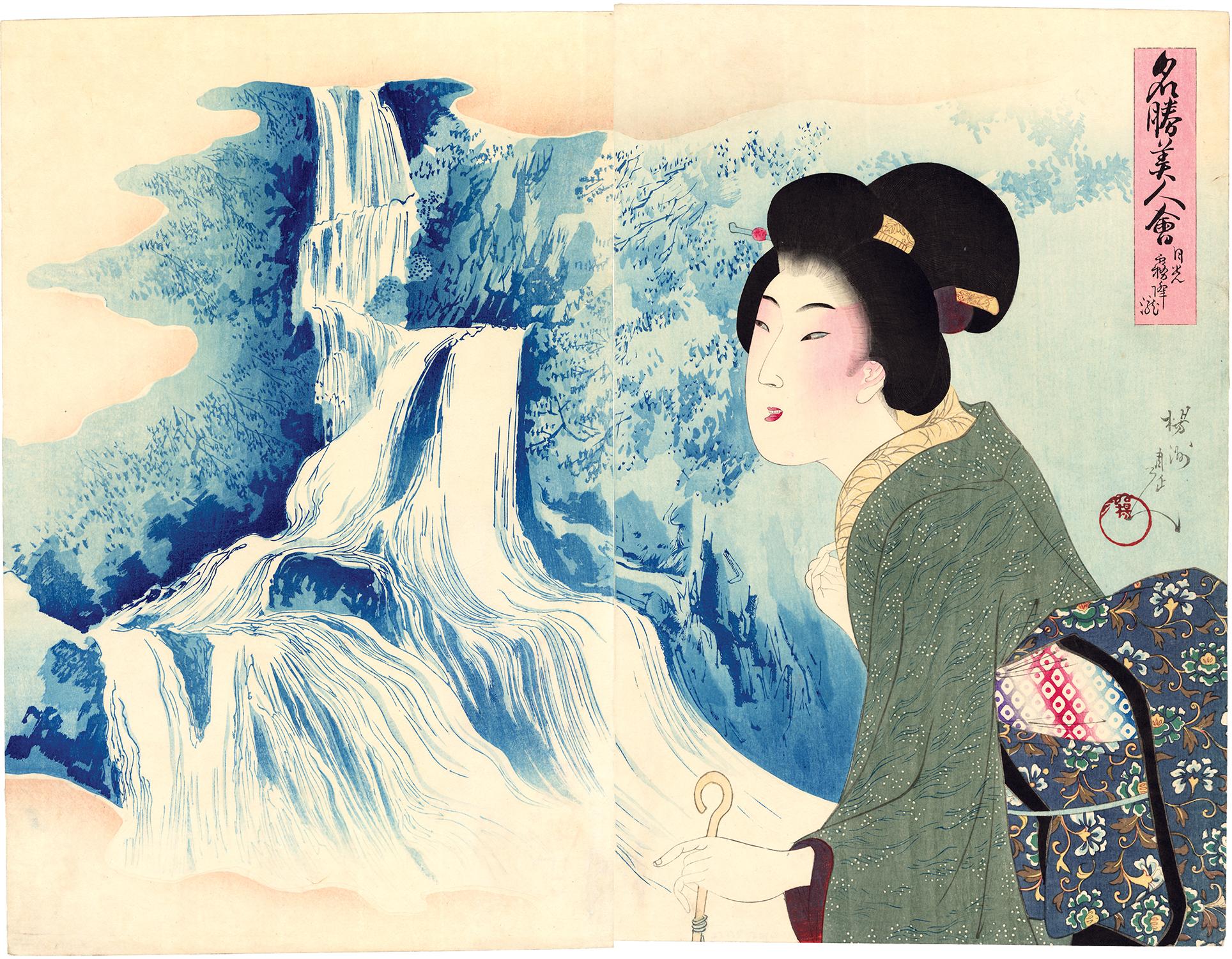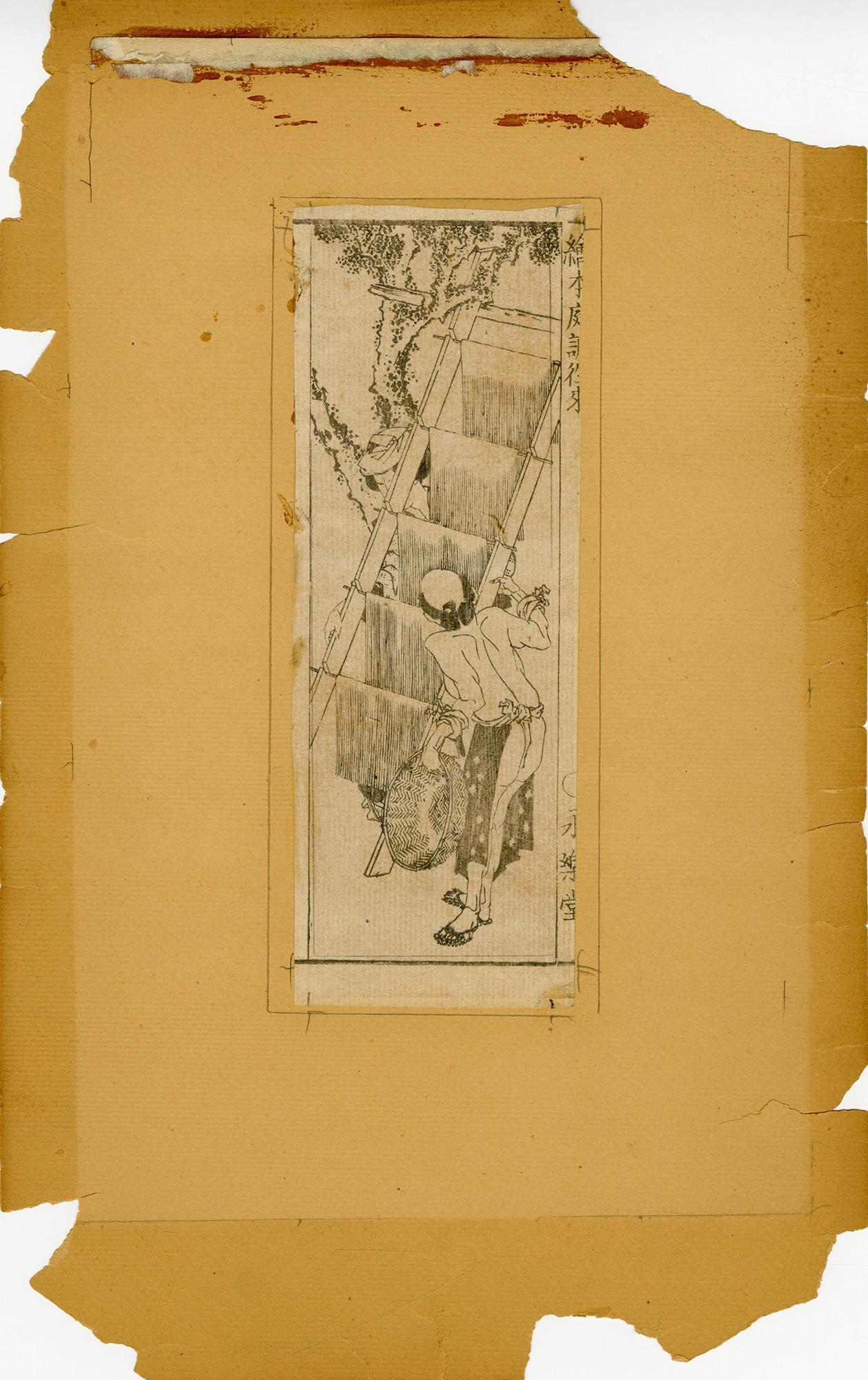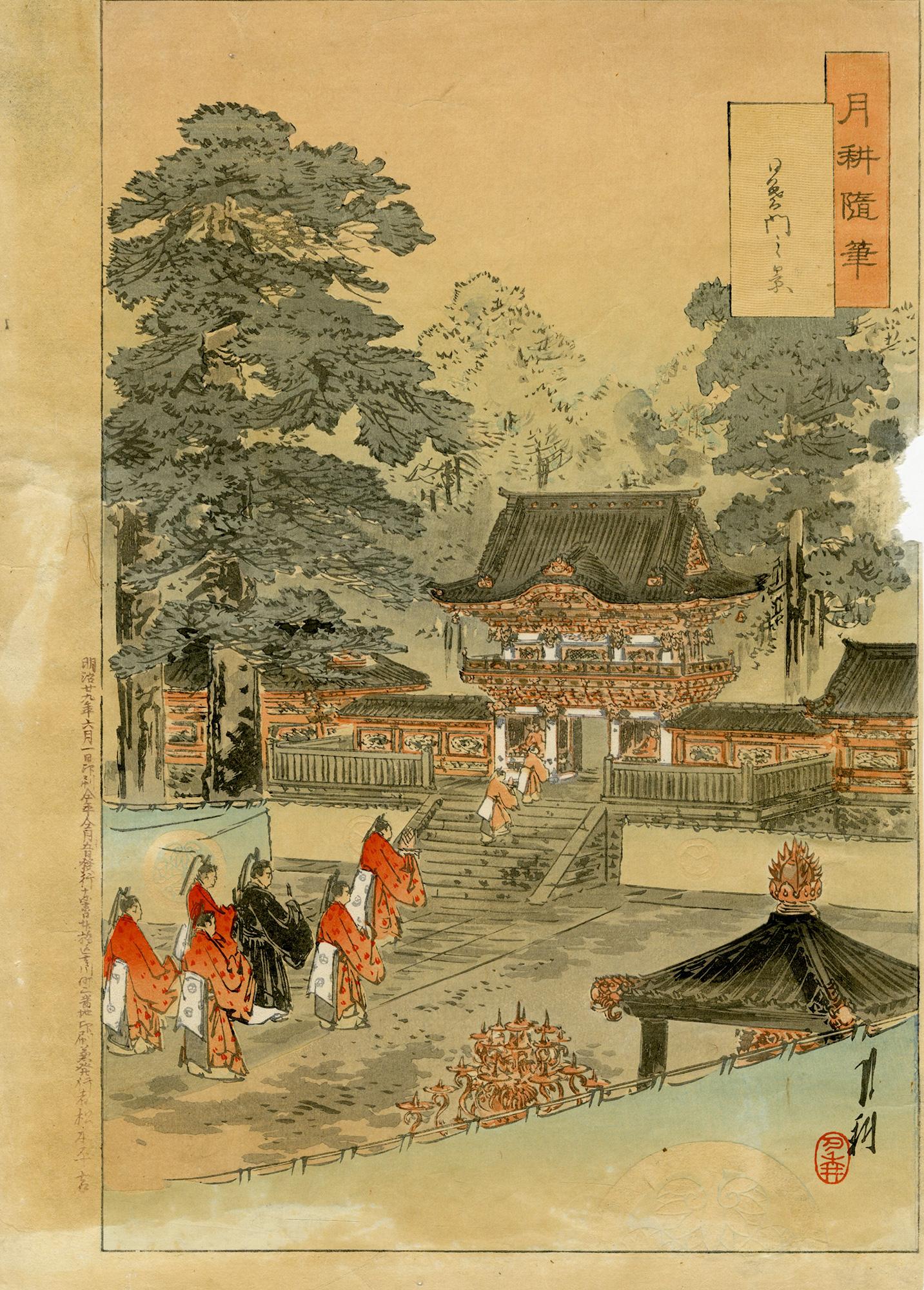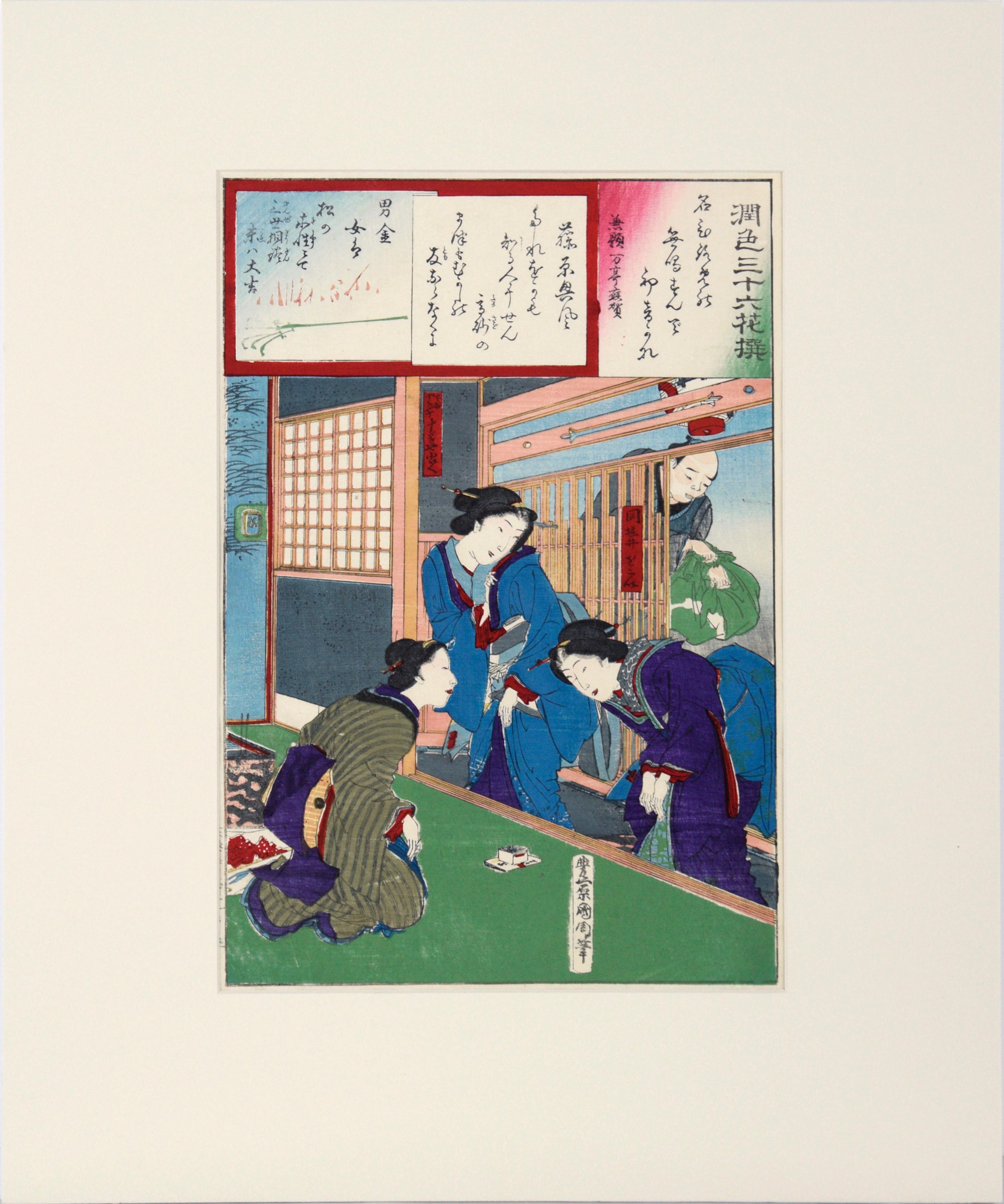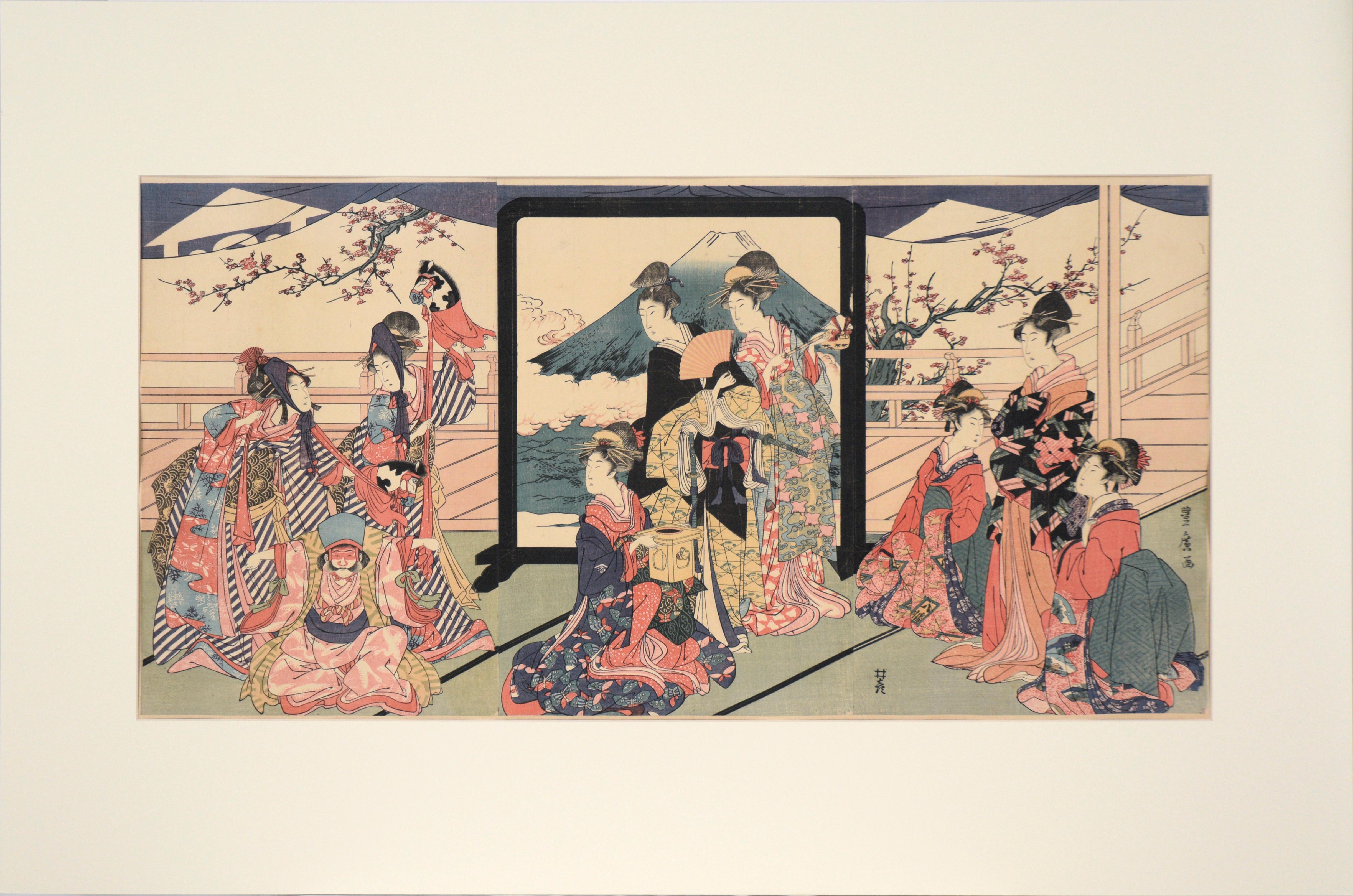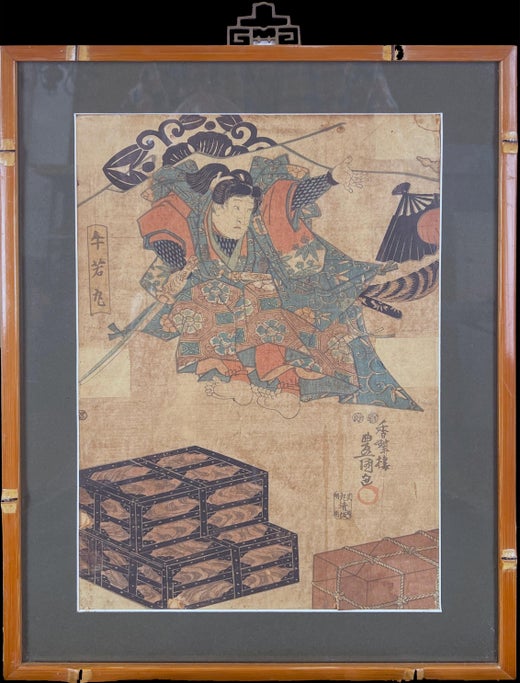Items Similar to Japanese Beauties Enjoy a Full Moon
Want more images or videos?
Request additional images or videos from the seller
1 of 10
Utagawa Kunisada (Toyokuni III)Japanese Beauties Enjoy a Full Moon ca. 1840
ca. 1840
About the Item
"Sun, Moon and Stars". Three beauties enjoy a full moon on the veranda of a teahouse or restuarant. The woman on the left kneels and adjusts her lavishly printed kimono. The beauty in the center has her hair down, and behind her is a screen against which shadows are beautifully silhouetted, which adds an air of mystery. The seated woman on the right is perhaps a geisha, as we see a shamisen lying next to her. Before her is a tray with an assortment of foods. One may surmise that the beauties are being compared to the sun, the moon, and the stars. On the left we glimpse a full moon shining over the peaceful bay, and boats at harbor. Original first edition Japanese color woodblock print triptych showcasing beautiful kimono and textile designs. Signed: Kochoro Kunisada ga. Sold unframed, although a high-quality custom frame is also available. The mastery of the Japanese woodblock print artists and artisans from this period has never been equalled. An elegant and sophisticated artwork that would be a focal point for any room. Utagawa Kunisada is rightly celebrated for his depictions of beautiful women, and he excelled at this triptych format.
- Creator:Utagawa Kunisada (Toyokuni III) (1786-1864, Japanese)
- Creation Year:ca. 1840
- Dimensions:Height: 14.18 in (36 cm)Width: 29.06 in (73.8 cm)
- Medium:
- Movement & Style:
- Period:
- Condition:Excellent impression, color and condition. Minor trimming. Rare to find a work from this period in this condition.
- Gallery Location:Burbank, CA
- Reference Number:
Utagawa Kunisada (Toyokuni III)
Born in the Honjo district of Edo as Kunisada Tsunoda, Kunisada’s family owned a small hereditary ferryboat service. Though his father, an amateur poet, died when Kunisada was a child, the family business provided some financial security. During his childhood, he showed considerable promise in painting and drawing. Due to strong familial ties with literary and theatrical circles, he spent time studying actor portraits. At age 14, he was admitted to study under Toyokuni, head of the Utagawa school. Kunisada's work embodies the characteristics of the Utagawa school, focusing on traditional subjects such as kabuki, bijin (beautiful women), shunga (erotic prints), and historical prints. His first known print dates to 1807, his first illustrated book to 1808. Kunisada’s career took off from the beginning. Many of his works became overnight successes and he was considered the “star attraction†of the Utagawa school. He signed his works “Kunisada,†sometimes with the studio names of Gototei and Kochoro affixed. In 1844, he adopted the name of his teacher and became Toyokuni III. Kunisada passed away in 1864 in the same neighborhood that he was born. He was 70 years old. Kunis
About the Seller
5.0
Recognized Seller
These prestigious sellers are industry leaders and represent the highest echelon for item quality and design.
Established in 1975
1stDibs seller since 2015
57 sales on 1stDibs
Associations
International Fine Print Dealers Association
- ShippingRetrieving quote...Ships From: Burbank, CA
- Return PolicyA return for this item may be initiated within 14 days of delivery.
More From This SellerView All
- Japanese Beauty Admiring Kirifuri WaterfallBy Yoshu ChikanobuLocated in Burbank, CAA beauty turns to admire the Kirifuri Waterfall in Nikko Province. She holds the handle of an umbrella and wears fashionable clothing that is beautifully printed. This series pairs f...Category
1890s Edo Landscape Prints
MaterialsMulberry Paper, Handmade Paper, Woodcut
- Beauties on the Beach with view of Mount FujiBy Yoshu ChikanobuLocated in Burbank, CAShichirigahama, Sagami Province. A beauty in the foreground waves to her young companions, who run towards her on the beach. The beauty at left wears a western-style golden ring. We ...Category
1890s Edo Landscape Prints
MaterialsMulberry Paper, Handmade Paper, Woodcut
- The Boy Botaro and his Nurse Otsuji and a Lotus PondBy Taiso YoshitoshiLocated in Burbank, CAThe boy Bôtarô watches his nurse Otsuji haul a bucket of water from the well. From the kabuki play Osanago no adauchi. Most interesting is the lush backdrop of lotus flowers and pump...Category
1880s Other Art Style Figurative Prints
MaterialsWoodcut, Mulberry Paper
- Itsukushima Moon--A Muro CourtesanBy Taiso YoshitoshiLocated in Burbank, CAA courtesan in Heian period style looks over the prow of her watercraft, looking ahead through the famous torii of Miyajima (Itsukushima) Shrine. She will be dancing in the ceremonies of the annual festival held in Itsukushima in the sixth month of the lunar calendar. Note the ukiyoe style of the beauty and the water, and the Shijo style of the rendering of the torii and the shore. Her enormous traveling hat and veil are placed beside her. From the series "One Hundred Famous Views of the Moon...Category
1880s Other Art Style Figurative Prints
MaterialsWoodcut, Mulberry Paper
- Ôkubo Hikozaemon Protects the Hidden Shogun TriptychBy Taiso YoshitoshiLocated in Burbank, CA“War Chronicles of Osaka” (Osaka gunki no uchi). Okubo Hikozaemon, raising his sword, protects the hidden Tokugawa shogun from the spear of Gorô Matabei Mototsugu in a moonlit fores...Category
1880s Other Art Style Figurative Prints
MaterialsWoodcut, Mulberry Paper
- Chiyogaike Pond, Meguro from 100 Famous Views of EdoBy Utagawa Hiroshige (Ando Hiroshige)Located in Burbank, CAA cascading waterfall fills Chiyo’s Pond, named after an ancient samurai’s wife. Cherry trees in full bloom line the banks of the pond. The reflections of the trees in the pond are a notable feature, as Hiroshige did not use reflections in very many of his prints, as it was something of an exotic import. From the series One Hundred Famous Views of Edo...Category
1850s Edo Landscape Prints
MaterialsWoodcut, Mulberry Paper
You May Also Like
- Drying PaperLocated in Middletown, NYWoodcut on cream laid paper, 7 1/4 x 2 1/2 inches (182 x 63 mm), narrow margins. Laid down to non-archival board with scattered soiling and some adhesive staining. Okumura Masanobu (Japanese 1686 – 13 March 1764) was a Japanese print designer, book publisher, and painter. He also illustrated novelettes and in his early years wrote some fiction. At first his work adhered to the Torii school, but later drifted beyond that. He is a figure in the formative era of ukiyo-e doing early works on actors and bijin-ga ("pictures of beautiful women"). While Masanobu's early life is largely undocumented, he is believed to have been born about 1686, possibly in Edo (modern Tokyo). Edo was a small fishing village when Tokugawa Ieyasu chose it as his administrative capital of the Tokugawa shogunate, and by the early 17th century the city had prospered and its population had grown to half a million. Masanobu appears to have been self-taught painter (though he did study poetry under Tachiba Fukaku); he is not known to have belonged to any artistic school. His early work shows the influence of the Torii school of ukiyo-e painting...Category
Early 18th Century Edo Figurative Prints
MaterialsHandmade Paper, Woodcut
- Toshogu ShrineLocated in Middletown, NYIn image of the Tokugawa family paying homage to Tosho-gu Shrine in Nikko. Tokyo: Matsuki Heikichi, 1896 Woodcut in ink with embossing and hand-coloring in watercolor on handmade m...Category
Late 19th Century Edo Figurative Prints
MaterialsHandmade Paper, Watercolor, Woodcut
- "Enshoku Sanju-roku Kasen" (Thirty-six Enchanting Flowers) Woodblock on paperBy Toyohara KunichikaLocated in Soquel, CA"Enshoku Sanju-roku Kasen" (Thirty-six Enchanting Flowers) Woodblock on paper Elegant woodblock print by Toyohara Kunuchika (Japanese, 1835-1900). Three women are in talking with each other inside, while a man waits outside holding a bag of some kind. The colors in this piece are rich and saturated, primarily blues, greens, and purple. Mat size: 16"H x 20"W Paper size: 14.75"H x 9.88"W Born in 1835, Toyohara Kunichika grew up in the Kyobashi district of Edo in the midst of merchants and artisans. In 1848, at age 13, he was accepted as an apprentice into the studio of Utagawa Kunisada I...Category
1880s Edo Figurative Prints
MaterialsInk, Rice Paper, Woodcut
- "Toy Horse Dance" Japanese Woodblock Triptych with Beauties and Mt FujiLocated in Soquel, CA"Toy Horse Dance" Japanese Woodblock Triptych with Beauties and Mt Fuji Vibrant three-panel woodblock print by Utagawa Toyohiro (Japanese, 1773–1828). Court ladies look on as a grou...Category
Early 20th Century Edo Figurative Prints
MaterialsWoodcut, Rice Paper, Ink
- Kiyomizu Temple, Scenes of Famous Places along Tôkaidô Road - Woodblock on PaperBy Utagawa Hiroshige IILocated in Soquel, CAKiyomizu Temple, Scenes of Famous Places along Tôkaidô Road - Woodblock on Paper Full Title: Kyoto: Kiyomizu Temple (Kyô Kiyomizudera), from the series Scenes of Famous Places along...Category
1860s Edo Landscape Prints
MaterialsInk, Rice Paper, Woodcut
- "Various Himochi" Wagashi Festival Japanese Woodblock Print by Utagawa ToyokuniLocated in Soquel, CA"Various Himochi" Wagashi Festival Japanese Woodblock Print by Utagawa Toyokuni Rare oversized early 19th century 5-tiered woodblock by Utagawa Ichiyosai Toyokuni, (Japan, 1769-1825), a Japanese lord and wife oversee a sekku festival of food, music, and dolls or toys. '"oshi" is the first day of “Mi (Snake)” in the third month of the lunar calendar. This day, known in modern Japan as the Girls' Festival, originated in China as a form of purification ceremony in which water and drinking peach blossom wine were used to drive away evil. Many kinds of hishi-mochi appear in this picture of hina ningyo (dolls associated with Hinamatsuri, or the Girl’s Day) from Omochae. The custom of eating special dishes at events throughout the year and at milestones in people's lives has existed since ancient times. This paragraph specifically focuses on the annual event called sekku, and life events that involve eating sweets. Joshi is the first day of “Mi (Snake)” in the third month of the lunar calendar. This day, known in modern Japan as the Girls' Festival, originated in China as a form of purification ceremony in which water and drinking peach blossom wine were used to drive away evil. According to the Keiso saijiki, in ancient China, on the third day of the third lunar month, people ate “ryuzetsuhan,” which is the juice of gogyo (Jersey cudweed) mixed with rice flour and nectar. In Japan, there is a record in the Heian period history book Nihon Montoku tenno jitsuroku [839-5] that it was an annual event to make kusamochi using gogyo on the third day of the third month of the lunar calendar, which may have been influenced by Chinese customs. The tradition of eating kusamochi on the third day of the third month of the lunar calendar continued after that. By the Edo period, however, hishimochi had come to be used as a sweet to serve on the third day of the third month. A picture of a hishimochi is included in the Morisada manko , which we mentioned in Part 1. According to it, hishimochi in the Edo period were often three layers of green-white-green instead of the now common red-white-green. However, it is possible to see from our collection that not all hishimochi were made in this way. Omochae published in 1857, is a good example. Omochae is a type of ukiyoe print...Category
1820s Edo Figurative Prints
MaterialsInk, Rice Paper, Woodcut
Recently Viewed
View AllMore Ways To Browse
Antique And Artisan
Moon Antique
Antique Moon
Antique Print Room
Antique Textile Designs
Sun Moon
The Antique Print Room
Kimono Print
Moon Stars
Moon And Stars
Japanese Hair
With Stars And Moons
Printed Tray
Sun And Moon In Room
Japanese Kimono Prints
Japanese Kimono Print
Antique Japanese Textiles Textiles
Antique Japanese Textile
